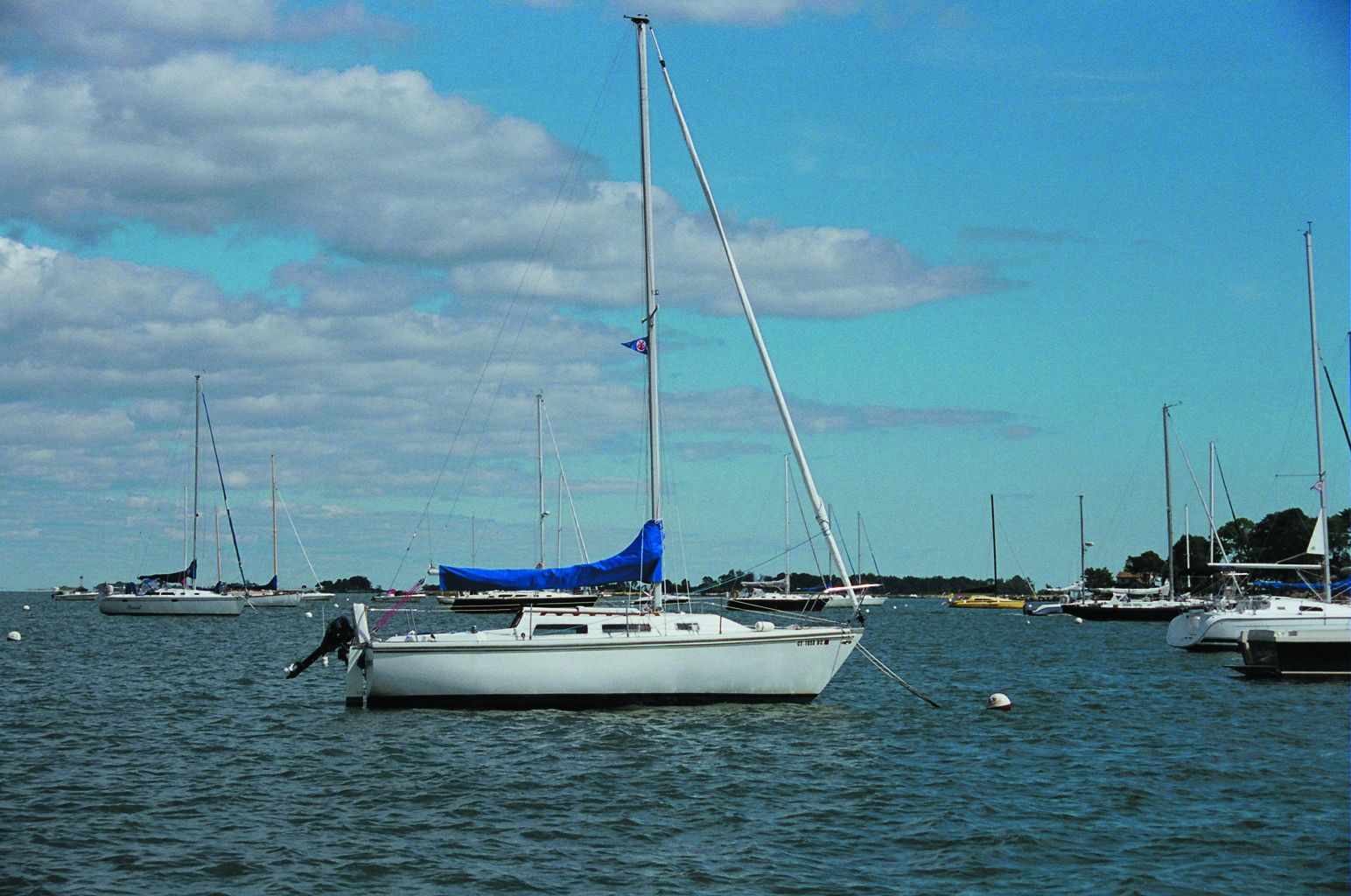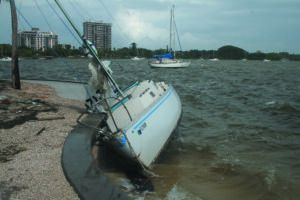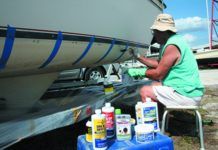DREMEL POLISHING BOBS
Regarding your recent blog post on corrosion (see “Fighting Off Marine Electrical System Corrosion,” PS Online), when cleaning up corroded terminals and lugs, I’ve found polishing bobs on Dremel tool to be useful. This is much easier than using sandpaper or a file and does a superior job in confined areas. The terminals are like new when you’re done. The bobs are rubber embedded with a silicon carbide or aluminum oxide that cuts quickly with light pressure. They are available in a variety of grits.
Ron & Ellen Kraus
48’ Custom Bruce Marek
Annapolis, MD
WIRE CORROSION REDUX
Even tinned wire does not guarantee freedom from corrosion. The cut ends are not tinned, and tin is just “better” than copper, not impervious. I have found using an anti-oxidative compound (originally developed to improve copper-to-aluminum connections) inside the crimp connector dramatically improves the connection’s resistance to corrosion (heatshrink with adhesive lining is still required). Also, the use of dielectric jelly in all quick-connects (1/4” spade, bullet, even fancy “waterproof” connectors) helps keep moisture and corrosion out. Both items offer very cheap insurance for years of troublefree connections.
Len Taft
Via PS Online
VELCRO FOR COCKPIT SCREENS
I am going to try and make a screen surround for my Island Packet 350. I would like to know specifically which product of Scotchmate hook-and-loop fasteners could be used to adhere to the cloth Bimini. I would also like to stick it on the cockpit fiberglass. It does not have to last forever. I was looking at the Scotchmate Hook and Loop Fastener MP3526N/27N. I was going to bind the edges of the screening with canvas and adhere the fastener to it and then hopefully use the other side on the Bimini.
Rick Van Enige
via PS Online
Self-adhesive hook-and-loop fasteners like the one you are considering will adhere well to many interior fabrics if you first apply 3M Super 77 to the fabric and let it dry until it is tacky. Outside, however, UV rays will degrade the glue. Also, Sunbrella is a difficult surface to work with. All of our experiments with adhesives on this surface have failed within 1-2 years. For better results, sew the strips to the Sunbrella. Self adhesive products might stick to your gel coat for while, but glued-on is much better. Remember to glue the felt part on the boat, because the exposed hooks will catch on fleece and knit clothing.
CHOOSING THE BEST BINOCULARS
Regarding Drew Frye’s recent report on binocular optics, there are several factors that I find important (see “Binos and Aging Eyes,” PS January 2022): What boat will you be using binoculars on—sail or power? (The relative motion is quite different.) Second, do you care about daylight hours or at night. And finally, does the user wear glasses or not?

I am a bit obsessed with binoculars and have more from many manufacturers than any normal person should, from high-end Steiner’s to mid-range models from Nikon, Bushnell, Fujinon and Celestron, as well as lower-end offerings from Walmart. To me weight, field of vision, and eye relief will be most important for sailors young and old.
While you reviewed options from Steiner and Nikon, I was quite surprised that you did not look at other brands, such as Bushnel and especially Fujinon. I am just shy of 70 and have found the Fujinon Mariner series to be my go-to binoculars for decades as they have the most comfortable, at least for me, combination of weight, field of vision and eye relief. I have found them so on both power and sailboats.
I also have stabilized binoculars which shine on a rough day, but are overkill in most conditions. I have found that my Steiners seem marginally better for night work. In short, I believe the age of user is less important than a user of any age finding the binocular that “feels” the best when being used with the type of boat they have in the environment they most often sail.
Peter Bigelow
SV Limerick Catalina 25
Rowayton, CT
Thanks for your insight. We’ve tested binoculars from all of the manufacturers you mention. You can find all the test results by searching “binocular” on our website. All of the factors you describe are indeed important when choosing a marine binocular, and, as you point out, the differences will vary by conditions and use, and are usually be readily apparent when you do a side-by-side test. The point of our most recent piece specifically focused (excuse the pun) on the relationship between objective lens diameter and pupil dilation of aging eyes, which would apply equally to every manufacturer.
THERMODYNAMICS CORRECTION
I want to correct a couple of technical errors in Drew Frye’s helpful February article about binoculars.
1. He begins by stating what he refers to as “the first law of thermodynamics”. But he then presents Lord Kelvin’s statement of the second law of thermodynamics. The second law has no bearing on binoculars or other optical devices. Even the First Law of thermodynamics (a statement about the conservation of energy) has no relevant bearing on optical devices.
2. Drew suggests that larger objective lenses do not make the image brighter. Lenses can concentrate light into a smaller area thus increasing the brightness. How else can you ignite a leaf with a magnifying lens? Brightness is the amount of visible power per unit area. The brightness will vary as the ratio of objective diameter area to exit pupil area. However as Frye mentions, if all the light does not fall on the eye pupil then the increase in brightness is lost as far as our perception is concerned.
Richard Packard
SV Dancer, Tiffany Jayne 34
Point Richmond, SF Bay
Good catch! Thank you. We’ve fixed the online version of the article to correct our thermodynamics blunder. We suspect the increase in these types of errors during the height of our bottom paint testing season is no coincidence.
We’ve also edited the article to make it more clear the brightness, or illuminance that Frye was referring to was the visible light measured in lumens, the unit used to quantify the total amount of luminous flux being emitted by the source. Brightness is also measured in lux, which refers to the lumens per square meter upon the surface of the object being illuminated.
While focusing effect of a lens can increase the lux at a precise spot, it, of course, does not create any additional lumens as the light passes through it.
As you mention, the key take away in our discussion of objective lens size on binoculars is that older eyes often can not take full advantage of 7 x 50 lenses. This is because light that is focused by the binocular lenses spills outside the periphery of their pupils which cannot dilate as wide as those of a younger person.
MULTI-TOOL FOR SANDING
Regarding your Rhumb Lines post on detail sanding (see PS April 2022). For sanding paint in nooks and crannies, you mentioned scrapers and sanding sponges. But you didn’t mention my go-tool tool for those hard to sand spots. That’s the oscillating multi-tool. Just add a triangular rubber plate attachment, select the right stick-on sandpaper, and press the trigger.
On boats it works well in corners and most of the tighter spots. It takes a lot less effort than manual sanding. And now most brands now offer this tool in a cordless model.
Gary Kellner
Halestorm, Beneteau First 35S5
Westwood, Mass.
WHAT ABOUT RECTORSEAL?
Regarding your recent test of waterproof epoxies (see “Underwater Epoxies,” PS December 2020), did you attempt to test kits from the hardware store for emergency water pipe repairs? For instance, RectorSeal’s Pipe Repair Kit, available at Home Depot? They use a water-activated epoxy that sets in 10 minutes. I wonder how they would do for below-water repair.
John Morfit
Atlantic 47 Catamaran
Deale, Md.
We have not tested this, but we have encountered a few pipe repairs using this product that did not last long. Note that the kit does not include the EP-200 putty it is supposed to be used with. We do think that a layered pipe repair involving waterproof epoxy putty reinforced with a fiberglass tape (or even a strip of Sunbrella) is a viable approach to pipe repair.
REMOTE MONITORING SYSTEMS
Has Practical Sailor reported on security/ safety systems (remote monitoring, high water alerts, geo fencing, etc)? With the prevalence of smart phones and apps connecting our world I was wondering whether something might be in the testing or analysis phase and that you planned to have an article sometime in the near future?
It seems like there is a lot of interesting stuff on the market these days.
Kirk Corkery
Dragonfly II, Hunter 44DS
Amherst Island, ON
Remote, wireless security systems have certainly proliferated on the market recently. We looked at a few recently, and will be again revisiting this topic (see “Wireless Boat Monitoring,” PS April 2019). Any readers who have recommendations can send them to [email protected].
REGARDING RECOATING MASTS
Regarding your report on refinishing masts (PS June 2021). It’s not a good idea to scrub the aluminum with a stainless-steel brush. Tiny particles of stainless can embed into the softer aluminum adding to the dissimilar metals issue. Scrubbing with a Scotch Brite pad, especially the more abrasive ones if needed will avoid this problem.
Rob Michaelson
1986 Hood Gulfstar Custom 40
Bodkin Creek YC, Chesapeake Bay
It seems many of us are always “shopping” for the next boat, or our forever boat. Some of us are simply windowshoppers, content with browsing boat sale websites and dreaming of a longer waterline or less brightwork. But if you’re a more serious shopper, here are some Practical Sailor archive articles we suggest checking out.

NEW BOAT SHOPPING
The PS archive includes dozens and dozens of sailboat reviews, from trailersailers and small cats to racer-cruisers and bluewater voyaging boats built for a family of four. You can search the reviews using the alphabetical index link under the “Sailboat Reviews” tab on the homepage. Also the two-volume ebook series “Entry-level Cruiser- Racer” is a compilation of boat reviews of popular racing-cruising boats; you can buy it in our online bookstore.

If you’re planning to carry out a preliminary boat survey—or just want to be wellversed when you go shopping—read our do-it-yourself survey checklist for boat-buyers in the June 2012 issue. Another excellent resource is our report on “Insuring Old Boats,” which was published in the April 2020 issue. New boat shoppers would also be well-served by investing in several of the resource books in our online bookstore (www.practical-sailor.com/products), especially Don Casey’s “Inspecting the Aging Sailboat.” On the fence about making that big purchase? Consider a peerto- peer boat rental (see PS July 2015 online) or fractional boat ownership (see PS July 2006).
GALLEY OUTFITTING
Before you outfit your galley for cruising— or even weekend sailing—be sure to read these performance tests and long-term product reviews of galley tools. For those who need quick-fix dinners that can basically cook themselves while you’re on watch (or enjoying cocktail hour), you’ll find our report on pressure cookers in the December 2010 issue and thermal cookers in the September 2012. If you have more time—and more room—for meal-making and are in the market for a galley oven-range combo, you’ll find our latest test on those in the July 2007 issue, along with an update on our test of small stoves. Two other items we consider cruising-galley staples are the coffeemaker and nesting cookware. In the January 2014 issue, we looked at multiple ways of brewing the best onboard java, and testers put nesting cookware sets through their paces in the April 2009 issue. The October 2012 issue offers an in-depth look at galley design. And the May 2016 issue highlight a fuel-saving slow-cooker.

I just wanted to let you know that Bushnell Canada just replaced my marine binocular with no hassle at all. The light for integral the compass had died. Because of COVID-19, I had to ship it to them. From there, they evaluated it, found it defective and sent me a new set! It was fast, reliable, and friendly service that you might want to highlight in your magazine.
Guy Lazure
Hunter DS41
Gore Bay, Ontario
In 2017, I removed and re-bedded the bronze portlights on my 1976 Nor’Sea 27, sealing them with 3M 4000 UV, which seemed like a good choice. The portlights are solidly through bolted so not a lot of adhesion is required, and the outer edge of sealant between the boss and the backing plate is exposed to sunlight.
By 2019 a couple of them had started leaking, and when I re-did them I found the sealant had turned soft and gummy (see photo, right). Now all of them need to be re-done. I am thinking of using Sika 291 this time, but I am curious if you have heard similar reports of 4000 UV deterioration or if you have any advice. I haven’t used any strong cleaners on them. It is possible that one or two of them were sealed with leftover 4000 UV, but I know I used a full cartridge of fresh caulk on the project, so most, if not all, were done within the 24 hours after opening, which is now specified. The boat is moored in the Gulf of California, so it does get hot.
Perhaps I should be glad that at least the gummy mess makes it relatively easy to remove the portlights, but I had really hoped that this repair would last a couple decades, not a couple years.
David Kallgren
Beagle, Nor’Sea 27
Bahia Concepci n, BCS, Mexico
Since suffering a complete reversion failure of 3M 4200 in our own testing (see “Mailport: December 2021”, PS December 2021), Practical Sailor continues to research this issue. So far, 3M has offered no comment on the cause or global impact of the product failure. According to 3M, the reformulated 4000 UV has solved this issue. If you’ve had a similar experiences with adhesive sealants, send any details to [email protected].










































